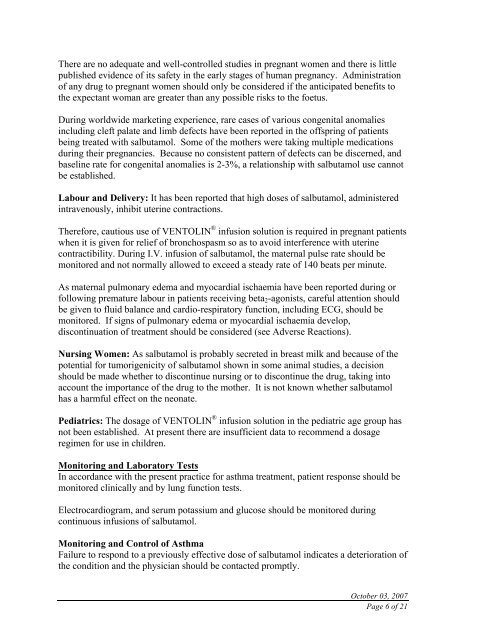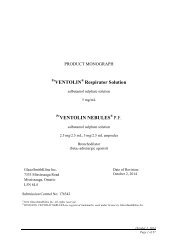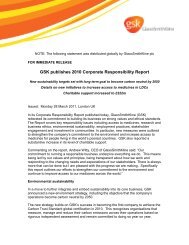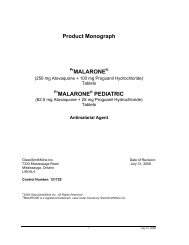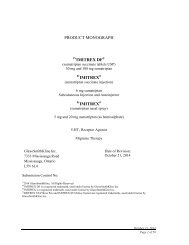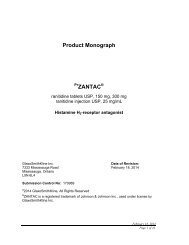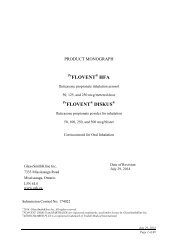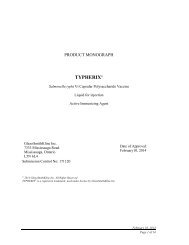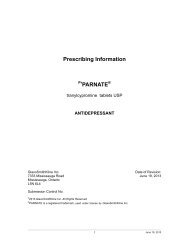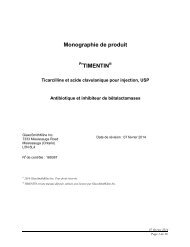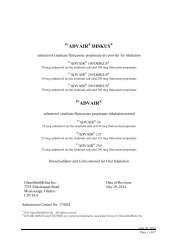VENTOLIN I.V. infusion solution - GlaxoSmithKline
VENTOLIN I.V. infusion solution - GlaxoSmithKline
VENTOLIN I.V. infusion solution - GlaxoSmithKline
Create successful ePaper yourself
Turn your PDF publications into a flip-book with our unique Google optimized e-Paper software.
There are no adequate and well-controlled studies in pregnant women and there is little<br />
published evidence of its safety in the early stages of human pregnancy. Administration<br />
of any drug to pregnant women should only be considered if the anticipated benefits to<br />
the expectant woman are greater than any possible risks to the foetus.<br />
During worldwide marketing experience, rare cases of various congenital anomalies<br />
including cleft palate and limb defects have been reported in the offspring of patients<br />
being treated with salbutamol. Some of the mothers were taking multiple medications<br />
during their pregnancies. Because no consistent pattern of defects can be discerned, and<br />
baseline rate for congenital anomalies is 2-3%, a relationship with salbutamol use cannot<br />
be established.<br />
Labour and Delivery: It has been reported that high doses of salbutamol, administered<br />
intravenously, inhibit uterine contractions.<br />
Therefore, cautious use of <strong>VENTOLIN</strong> ® <strong>infusion</strong> <strong>solution</strong> is required in pregnant patients<br />
when it is given for relief of bronchospasm so as to avoid interference with uterine<br />
contractibility. During I.V. <strong>infusion</strong> of salbutamol, the maternal pulse rate should be<br />
monitored and not normally allowed to exceed a steady rate of 140 beats per minute.<br />
As maternal pulmonary edema and myocardial ischaemia have been reported during or<br />
following premature labour in patients receiving beta 2 -agonists, careful attention should<br />
be given to fluid balance and cardio-respiratory function, including ECG, should be<br />
monitored. If signs of pulmonary edema or myocardial ischaemia develop,<br />
discontinuation of treatment should be considered (see Adverse Reactions).<br />
Nursing Women: As salbutamol is probably secreted in breast milk and because of the<br />
potential for tumorigenicity of salbutamol shown in some animal studies, a decision<br />
should be made whether to discontinue nursing or to discontinue the drug, taking into<br />
account the importance of the drug to the mother. It is not known whether salbutamol<br />
has a harmful effect on the neonate.<br />
Pediatrics: The dosage of <strong>VENTOLIN</strong> ® <strong>infusion</strong> <strong>solution</strong> in the pediatric age group has<br />
not been established. At present there are insufficient data to recommend a dosage<br />
regimen for use in children.<br />
Monitoring and Laboratory Tests<br />
In accordance with the present practice for asthma treatment, patient response should be<br />
monitored clinically and by lung function tests.<br />
Electrocardiogram, and serum potassium and glucose should be monitored during<br />
continuous <strong>infusion</strong>s of salbutamol.<br />
Monitoring and Control of Asthma<br />
Failure to respond to a previously effective dose of salbutamol indicates a deterioration of<br />
the condition and the physician should be contacted promptly.<br />
October 03, 2007<br />
Page 6 of 21


